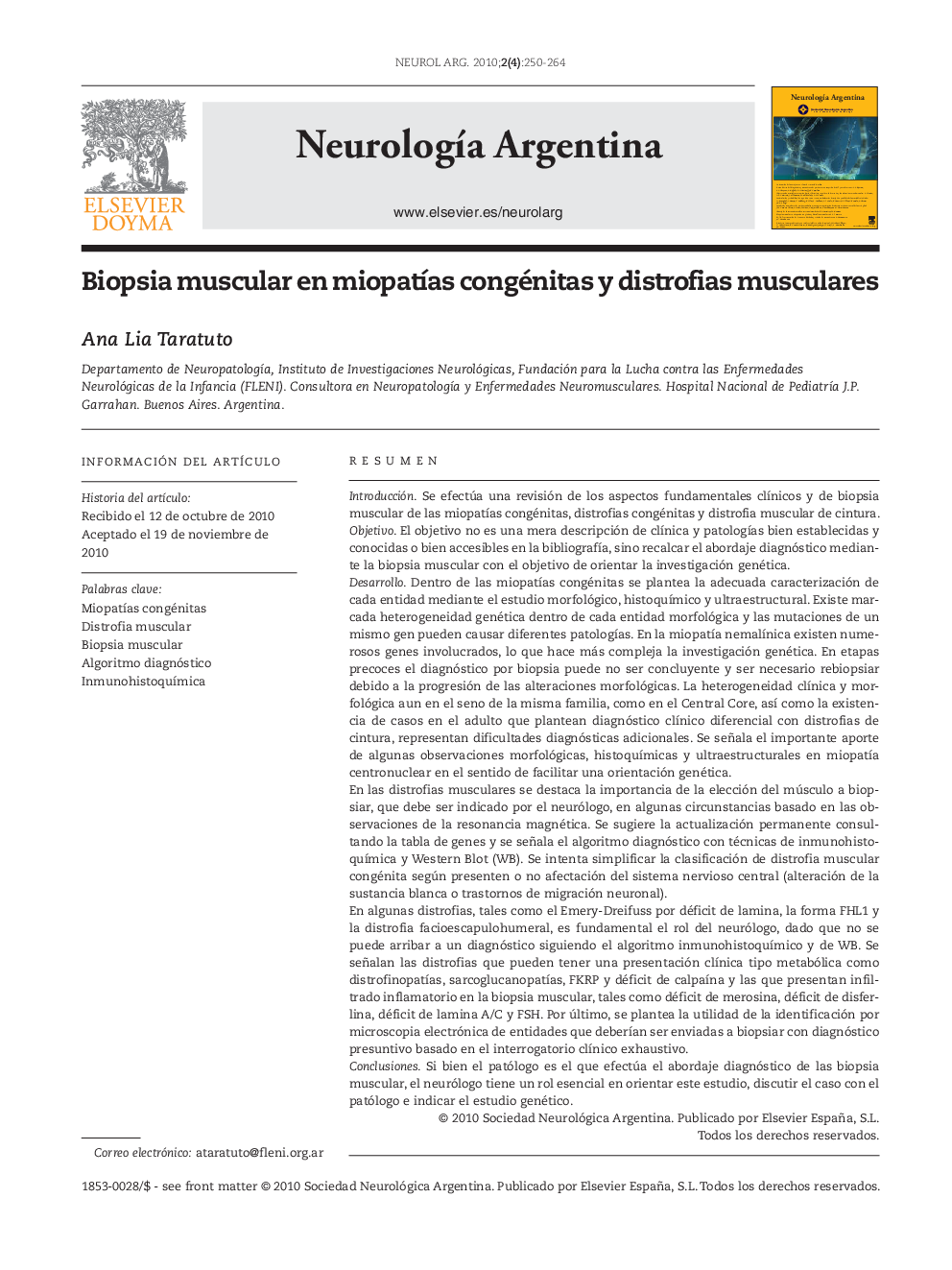| کد مقاله | کد نشریه | سال انتشار | مقاله انگلیسی | نسخه تمام متن |
|---|---|---|---|---|
| 3076927 | 1189110 | 2010 | 15 صفحه PDF | دانلود رایگان |

ResumenIntroducciónSe efectúa una revisión de los aspectos fundamentales clínicos y de biopsia muscular de las miopatías congénitas, distrofias congénitas y distrofia muscular de cintura.ObjetivoEl objetivo no es una mera descripción de clínica y patologías bien establecidas y conocidas o bien accesibles en la bibliografía, sino recalcar el abordaje diagnóstico mediante la biopsia muscular con el objetivo de orientar la investigación genética.DesarrolloDentro de las miopatías congénitas se plantea la adecuada caracterización de cada entidad mediante el estudio morfológico, histoquímico y ultraestructural. Existe marcada heterogeneidad genética dentro de cada entidad morfológica y las mutaciones de un mismo gen pueden causar diferentes patologías. En la miopatía nemalínica existen numerosos genes involucrados, lo que hace más compleja la investigación genética. En etapas precoces el diagnóstico por biopsia puede no ser concluyente y ser necesario rebiopsiar debido a la progresión de las alteraciones morfológicas. La heterogeneidad clínica y morfológica aun en el seno de la misma familia, como en el Central Core, así como la existencia de casos en el adulto que plantean diagnóstico clínico diferencial con distrofias de cintura, representan dificultades diagnósticas adicionales. Se señala el importante aporte de algunas observaciones morfológicas, histoquímicas y ultraestructurales en miopatía centronuclear en el sentido de facilitar una orientación genética.En las distrofias musculares se destaca la importancia de la elección del músculo a biopsiar, que debe ser indicado por el neurólogo, en algunas circunstancias basado en las observaciones de la resonancia magnética. Se sugiere la actualización permanente consultando la tabla de genes y se señala el algoritmo diagnóstico con técnicas de inmunohistoquímica y Western Blot (WB). Se intenta simplificar la clasificación de distrofia muscular congénita según presenten o no afectación del sistema nervioso central (alteración de la sustancia blanca o trastornos de migración neuronal).En algunas distrofias, tales como el Emery-Dreifuss por déficit de lamina, la forma FHL1 y la distrofia facioescapulohumeral, es fundamental el rol del neurólogo, dado que no se puede arribar a un diagnóstico siguiendo el algoritmo inmunohistoquímico y de WB. Se señalan las distrofias que pueden tener una presentación clínica tipo metabólica como distrofinopatías, sarcoglucanopatías, FKRP y déficit de calpaína y las que presentan infiltrado inflamatorio en la biopsia muscular, tales como déficit de merosina, déficit de disferlina, déficit de lamina A/C y FSH. Por último, se plantea la utilidad de la identificación por microscopia electrónica de entidades que deberían ser enviadas a biopsiar con diagnóstico presuntivo basado en el interrogatorio clínico exhaustivo.ConclusionesSi bien el patólogo es el que efectúa el abordaje diagnóstico de las biopsia muscular, el neurólogo tiene un rol esencial en orientar este estudio, discutir el caso con el patólogo e indicar el estudio genético.
IntroductionThis is a review of the main clinical and muscle biopsy aspects in congenital myopathies, congenital dystrophies and limb girdle muscular dystrophy.ObjectiveThe objective is not a description of well-known diseases but to emphasize a diagnostic approach through muscle biopsy findings in order to orientate the genetic investigation.DevelopmentIn the field of congenital myopathies and adequate characterization of each disease can be achieved with the morphological, histochemical and ultrastructural studies. There is genetic heterogeneity within each morphological entity and the same gene may be involved in different diseases. In nemaline myopathy genetic findings are more complex because there are many genes responsible of the same disease. Biopsy diagnosis may not be conclusive in early biopsies due to the progression of morphological changes, thus it may be necessary to repeat the muscle biopsy some months or years later. In Central Core Disease there may be clinical and morphological heterogeneity, even within members of the same family and some cases in adults may be interpreted from the clinical point of view as limb girdle muscle dystrophy. Morphological, histochemical and ultrastructural observations in centronuclear myopathy may be useful for genetic orientation.In muscular dystrophies, the election of the muscle for biopsy is of main importance and the neurologist should in occasions ask for an MRI for this purpose in order to choose a muscle not replaced by fatty tissue. In order to be updated gene table consultation is advisable; an immunohistochemical algorithm as well as Western Blot is proposed. Congenital muscular dystrophy classification is simplified, considering those with no central nervous system involvement and those with white matter changes or abnormal neuronal migration.In some limb girdle dystrophies such as Emery Dreifuss and FSH, the neurologist has a main role in the identification of the fenotype, because the muscle biopsy diagnostic algorithm performed for other muscular dystrophies doesn’t help to arrive to a correct diagnosis.Some muscular dystrophies may have a metabolic presentation such as dystrophinopathies, sarcoglucanoopathies, FKRP and calpainopathies. Other muscular dystrophies may have prominent inflammatory infiltration in the biopsy, such as dysferlin deficiency, lamin/C deficiency and FSH.Electron microscopy may be extremely helpful in some entities.ConclusionAlthough the pathologist does the diagnostic approach through the muscle biopsy, the neurologist has an essential role in the orientation of this study, discussion with the pathologist as well as genetic advise.
Journal: Neurología Argentina - Volume 2, Issue 4, October–December 2010, Pages 250–264